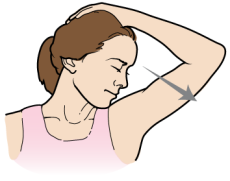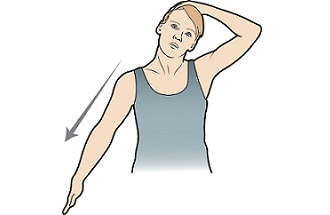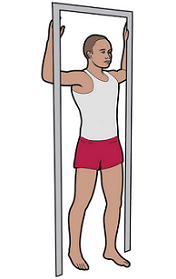This information will teach you how to do neck and shoulder exercises after your neck surgery.
About Exercising After Your Neck Surgery
After surgery, your neck and shoulder on the surgical side (involved side) may feel tight and weak. The exercises in this resource will help make your neck and shoulder muscles stronger and more flexible. This will help your shoulder and neck move and work like they did before your surgery.
Tips for Your Daily Life
While you’re recovering, doing your daily activities may be harder for you. Follow these tips for help.
- Always keep your shoulders back and relaxed, and your head retracted (pulled back). This will help you keep good posture. It also prevents you from having tightness in your chest muscles and from straining your neck and shoulder muscles.
- Lie on your back as much as possible when sleeping. If you must lie on your uninvolved side, rest the arm of your involved side on a pillow in front of you. This prevents you from pulling at your shoulder. Do not lie on your involved side unless your healthcare provider says it’s OK.
- Do not lift or carry anything heavier than 3 pounds (1.4 kilograms) on your involved side. For your reference, a steam iron weighs around 3 pounds while a half gallon of milk is 4 pounds. Talk with your healthcare provider before lifting or carrying things over 3 pounds.
- Do not carry a heavy shoulder bag or purse on your involved side. Check with your healthcare provider before you try to carry a backpack or knapsack.
Exercises
This section shows the exercises you should do after your neck surgery to help you heal. Start these exercises only when your healthcare provider tells you that it’s safe to do them. They will also tell you when your incision (surgical cut) has healed well enough to start these exercises. Starting too soon or too late can affect how well your shoulder and neck will work in the future.
Follow these tips when doing your exercises.
- It may be helpful to use a timer or clock to make sure you hold the stretches long enough.
- Breathe normally. Do not hold your breath during the exercises.
- Do the exercises slowly and smoothly. Do not make any fast or jerky movements.
- Watch your movements in a mirror to make sure you have good posture.
- Stop any exercise that causes pain, nausea, dizziness, swelling, or discomfort. Call your healthcare provider to tell them if this happens.
Do these exercises 2 times a day for 3 months. You may be able to move your shoulder and get full motion of your neck back before 3 months. If this happens, ask your healthcare provider if you can stop doing the exercises. If you cannot move your neck or shoulder after 3 months of doing these exercises, tell your healthcare provider.
Diagonal neck stretch: Up
Do this exercise 2 times every day.
- Gently turn your head so you’re looking up and to the right.
-
Place your right hand on your left cheek and jaw. Apply mild pressure to give yourself a deeper stretch (see Figure 1).

Figure 1. Diagonal neck stretch: up
- Repeat this in the other direction.
- Hold each stretch for 30 seconds, then relax. Take 1 full breath between each repetition. Repeat this 5 times on each side.
Diagonal neck stretch: Down
Do this exercise 2 times every day.
- Gently turn your head so you’re looking down and to the left.
-
Place your left hand on top of your head. Apply mild pressure to give yourself a deeper stretch (see Figure 2).

Figure 2. Diagonal neck stretch: down
- Repeat this in the other direction.
- Hold each stretch for 30 seconds, then relax. Take 1 full breath between each repetition. Repeat this 5 times on each side.
Side neck stretch
Do this exercise 2 times every day.
- Sit or stand and point your right arm downward.
- Place your left hand on top of your head.
-
Gently pull down your head toward your left shoulder, to stretch the muscles on the right side of your neck (see Figure 3).

Figure 3. Side neck stretch
- Repeat this in the other direction.
- Hold each stretch for 30 seconds, then relax. Take 1 full breath between each repetition. Repeat this 5 times on each side.
Pectoral stretch using doorway
Do this exercise 2 times every day.
- Stand in a doorway.
-
Place your hands and forearms at shoulder level on the sides of the doorway (see Figure 4).

Figure 4. Pectoral stretch using doorway
- Gently step forward until you feel a gentle stretch across your chest and in front of your shoulders. Keep your back straight, and your neck and shoulders relaxed.
- Hold for 30 seconds, then relax.
- Return to the starting position with your arms at your sides.
- Take 1 full breath between each repetition. Repeat this 5 times.
Chin tuck
Do this exercise 2 times every day.
- Sit or stand with your back and head leaning against the wall.
-
Tuck your chin in and try to flatten the back of your neck against the wall (see Figure 5). Hold this position for 5 seconds, then relax.

Figure 5. Chin tuck
- Return to the starting position.
- Take 1 full breath between each repetition. Repeat this 10 times.
Jaw lowering
Do this exercise 2 times every day.
- Sit or stand in front of a mirror, so you can see your face.
- Place the tip of your tongue behind your top teeth.
-
Slowly lower your bottom jaw to open your mouth, while keeping your tongue in contact with the roof of your mouth (see Figure 6). Use the mirror to make sure you’re opening your mouth evenly, and not moving your jaw from side to side. Hold this position for 10 seconds, then relax.

Figure 6. Jaw lowering
- Close your mouth.
- Take 1 full breath between each repetition. Repeat this 10 times.
Backward shoulder rolls
Do this exercise 2 times every day.
- Sit up tall in proper posture.
-
Shrug your shoulders up toward your ears, then push your shoulders backward (see Figure 7).

Figure 7. Backward shoulder rolls
- Drop them down slowly.
- Take 1 full breath between each repetition. Repeat this 10 times.
Arm circles
Do this exercise 2 times every day.
- Sit or stand with your arms at your sides. Have your palms facing forward and your thumbs pointing to the ceiling.
-
Lift your arms up and circle them backward (see Figure 8).

Figure 8. Arm circles
- Return to the starting position.
- Take 1 full breath between each repetition. Repeat this 10 times.
Arm and shoulder retraction
Do this exercise 2 times every day.
- Sit or stand with your arms in front of you and your palms facing forward.
- Push your shoulders down and away from your ears. This stops you from shrugging.
-
Move your arms out to the sides, while squeezing your shoulder blades together (see Figure 9). Hold this position for 5 seconds, then relax.

Figure 9. Arm and shoulder retraction
- Return to the starting position.
- Take 1 full breath between each repetition. Repeat this 10 times.
Diaphragmatic (DY-uh-fra-MA-tik) breathing
Do this exercise 2 times every day.
- Lie on your back or sit in a supportive chair.
-
Place one or both of your hands over your abdomen (belly) (see Figure 10).

Figure 10. Diaphragmatic breathing
- Breathe in slowly and deeply through your nose. Your abdomen should rise but your upper chest should stay still and relaxed.
- Breathe out slowly through your mouth. As you breathe out, slowly and gently pull your abdomen toward your spine.
- Take 1 full breath between each repetition. Repeat this 10 times.